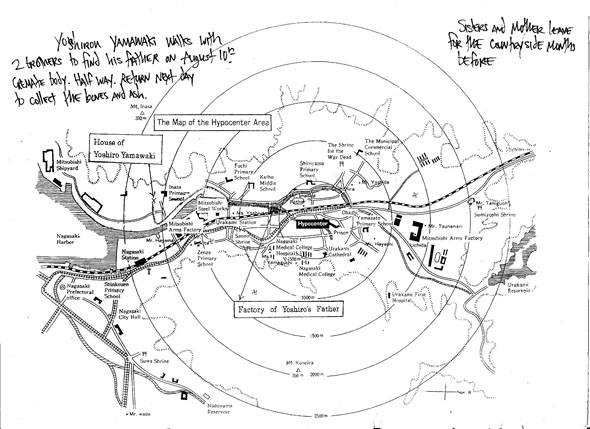..July 2010.. ..Nagasaki..
A snapshot of an article in Yomiuri newspaper about From Above photo exhibition at the Nagasaki Peace Museum.
Most of the press has been in Japanese.
..June 2010 Nagasaki..
A radio interview by Miki Morita broadcast on Nagasaki City FM about From Above photo exhibition by Paule Saviano at the Nagasaki Peace Museum.
Please click on the small arrow button to play the interview.
It is in half English and Japanese. I start speaking around 1:35 into the broadcast.
..June 2010 Nagasaki..
Article written in The Japan Times about the opening of From Above photography exhibition at the Nagasaki Peace Museum.
Ironically the article and photo are twice the size and above a story on the Japanese Prime Minister’s trip to the G20 Summit and the death of Japan’s oldest koala.
From Above photo exhibition
Photographs by Paule Saviano
Presented by Gallery EF, Nagasaki Peace Museum, & Community Media Company
Nagasaki Peace Museum
7-15 Matsugaemachi
Nagasaki, Japan
Tel: 095-818-4247
Closed Monday
June 29- July 19th, 2010
Open Reception June 29th 9:30-17:30
http://www.nagasakips.com
http://www.gallery-ef.com/fromabove.htm
http://www.paulepictures.com
..September 2008.. ..1 Block from the Epicenter, Nagasaki..
Mr. Katsuji Yoshida
76 years old
Monday 11AM
..Mr. Katsuji Yoshida was badly injured by the atomic bomb blast. 14 years younger than Mr. Obata, my first portrait, he was much more frail and nimble. His mind was sharp, some of the fine details not exact but concise.
He was the most delicate Hibakusha I met. Unable to be photographed outdoors because his skin was to sensitive to be in the sun. He wore a fisherman’s cap to protect his head. The right side of his face badly scarred from burns and an ear patch covering his missing ear. He walked well and didn’t need a cane. His mind was vibrant. You could still see the youth in his eyes and hear the energy in his voice.
August 9th, 1945 11:02AM
Yoshida-san was 13 years old.
Yoshida-san sees US planes dropping parachutes minutes before the atomic bomb was dropped. They were testing wind speed and direction for the drop. He clearly described hearing the engines as the planes glided over.
He was walking to school with 3 other boys about a ½ mile from the epicenter seconds before the atomic bomb was detonated. They were walking across a field and stopped at a well to get a drink of water.
He looked up and saw another set of parachutes drop. Suddenly the blast and violent light. He was sent flying through the air.
The boys were thrust up in the air, across the field, and a road. About 120 feet away from the well.
The impact of the atomic bomb threw him face first into a wet rice field. The soft mud absorbed the force of the turbulent blast and probably saved his life.
“…It didn’t hurt much…nobody was crying…..”
Yoshida-san describing the moment the atomic bomb exploded.
Coming to his senses….Seconds before he was a 13 year old boy walking to school. Seconds after the atomic bomb detonated….all his skin had peeled off his body. No skin left on his arms and legs. Only scorched skin left on his face.
He than washed off the mud in a nearby irrigation field. Found some surviving foliage and grass. Put grass on his face and body to cool down the scorched and missing skin. They decide to sit there and wait for help.
Minutes later women come out of a field badly burnt, crying, and screaming “…Help us…”. The scene ignited emotion in the numb 13 year old boys. They burst into a bombastic cry. This was the first time he and the other boys felt emotion.
The badly injured women drink from the Irakami River. The water was contaminated with radiation. They died quickly, bodies lied motionless on the river banks. Water slowly washing their burnt bodies.
Yoshida-san made a rule not to drink the water. He knew from school that not matter how much blood he lost when injured, never drink the water.
Looking around, all the buildings were destroyed or blazing. Nagasaki was an inferno. Corpses in every direction. Body parts randomly thrown. Intestines, pieces of brain, eye balls, split skulls, and unidentifiable faces littered the streets.
He didn’t feel anything. He didn’t know what he was looking at. Shock must have set in.
As the day grew old, the sun heated the grass covering his burnt body. His initial numbness transformed into throbbing pain. The moist grass dried against his exposed muscle. It was torture. He was not strong enough to walk. There was no shade. Nagasaki was a featureless landscape of char. Trees that survived the initial blast were quickly ablaze in the coming fires.
Yoshida-san happy to see the sun set after it beat on him while lying in the exposed field. His face started to swell. He could no longer see after his eyes began to swell shut.
At night, his skinless body shivered in the cold. The rescue team came the following day.
For 2 days he remained with other school children at a relief station set up in a school yard until his mother came to identify him. He doesn’t remember much, Only his mother’s voice, calling his name the next day. He raised his hand when he heard his name.
“…We were faint but we could answer our parents call…”
Yoshida-san
I’m interested to know what his mother’s voice sounded like. Was it a frantic scream? A mother finding her son alive after the Apocalypse. What was the look on her face? Her reaction….
The 2 boys died soon after.
He has no memory of the next 2 months he spent at home bed ridden. A hospital facility was set up 2 months later at a surviving elementary school. Than he was taken to a naval hospital outside of Nagasaki.
In December 1945, 4 months later, the skin on the left side of his face started to grow back. The burns on the right side of his body never recovered.
..April 2010.. ..Nagasaki..
“…It came so suddenly…we really didn’t feel pain…”
Mr. Katsuji Yoshida, about August 9th, 1945
Earlier today atomic bomb Survivor Mr. Katsuji Yoshida passed away from lung cancer.
In September 2008, I had the honor of meeting and photographing Yoshida-san for my From Above exhibition. Yoshida-san was very close to epicenter of the atomic bombing when it detonated over Nagasaki, probably 500m-1000m. He was one of the only Survivors that close to the epicenter.
The impact of the blast threw him face first into a wet rice field. Landing in the softness of the mud probably saved his life. He was badly injured and spent many months in the hospital. For 66 years, he would be in and out of the hospital dealing with injuries and illness caused by radiation exposure.
When I met him, he was very fragile but his spirit was still young and vibrant. He couldn’t be photographed outdoors because the sun was to harsh for his skin. As he walked through the Nagasaki Atomic Bomb Museum people would stop and Bow. He would speak to anyone who greeted him.
Yoshida-san dedicated his life to speaking about the horrors of the atomic bomb and the discrimination he overcame throughout his life being an Hibakusha. He traveled around the world speaking to anyone.
It was an honor meeting and photographing him. An experience I will never forget. The world has lost an important Human Being.
I will post the journal entries of Yoshida-san over the next couple of days.
..January 2010 Nagasaki..
On Monday, Tsutomu Yamaguchi-san passed away at the age of 93 in Nagasaki. He was a double hibakusha. Survivor of both atomic bombs in Hiroshima and Nagasaki.
He started to tell his story 65 years after the bombings. Here is an article from the Japan Times briefly describing Yamaguchi-san.
..September 2008 Nagasaki..
“I realized that I must live on behalf of those who died unwillingly. I have to tell what happened, so they will not die in vain.”
Sumiteru Taniguchi-san
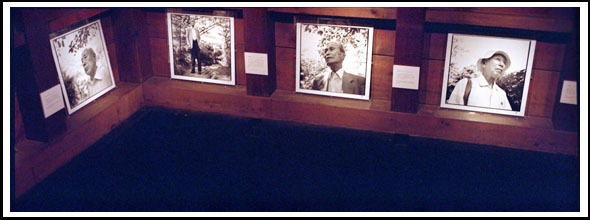
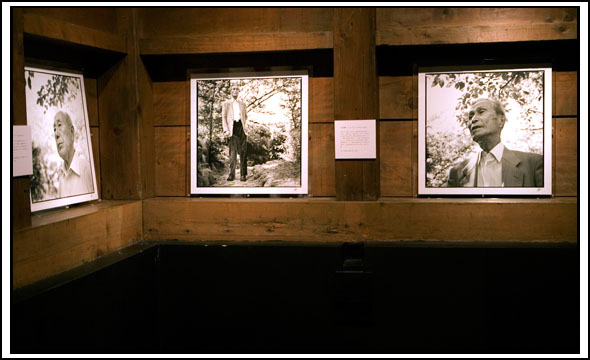
..September 2008 Epicenter, Nagasaki..
Yamawaki-san was the 3rd portrait taken on my first day of photographing in Nagasaki. I photographed him at the atomic bomb epicenter close to the other locations I photographed the entire project. All of the portrait locations were taken within 300 feet of each other.
Yamawaki-san’s portrait was one of the more challenging portraits. He had a very serious demeanor. It wasn’t until seeing the print at the exhibition in Gallery EF did I see the softness in his eyes.
In the gallery, the serious tone on his face felt lighter and more reflective. A lot less tension in his face than in my original thoughts. His shoulders on the print were relaxed and softer around the edges.
What also felt different about his portrait and conversation was he was the only Hibakusha who spoke English. It brought a different dynamic to our friendship. Not that I felt more comfortable with him because we spoke the same language. I was very comfortable communicating in Japanese through a translator with everyone I met.
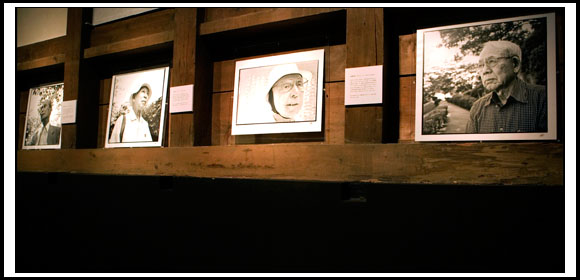
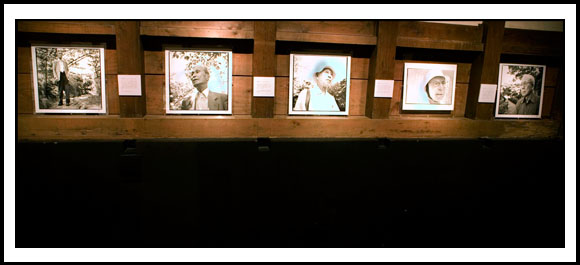
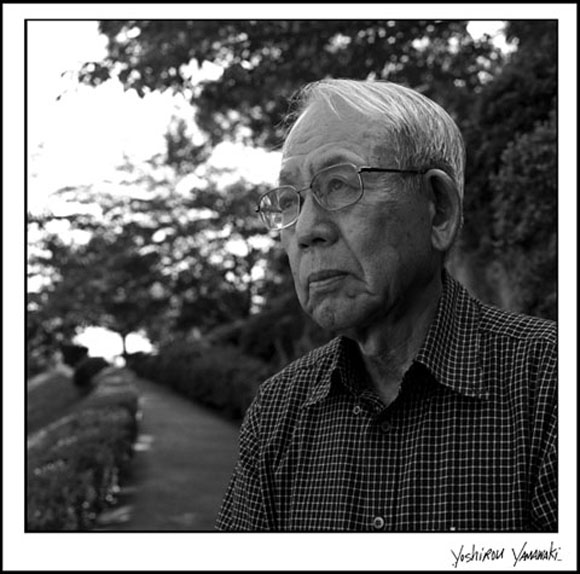
..September 2008 Nagasaki..
Map of Yamawaki-san’s journey to recover his father’s body the day after atomic bomb was dropped on Nagasaki.
